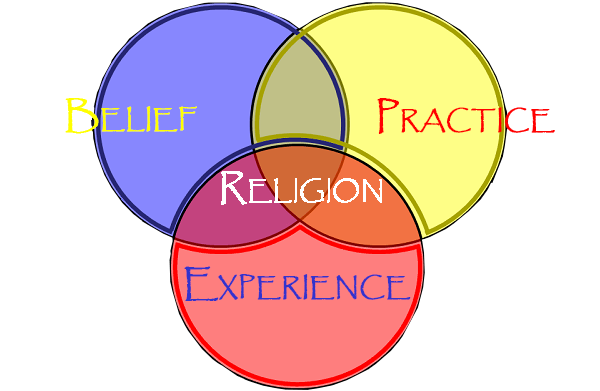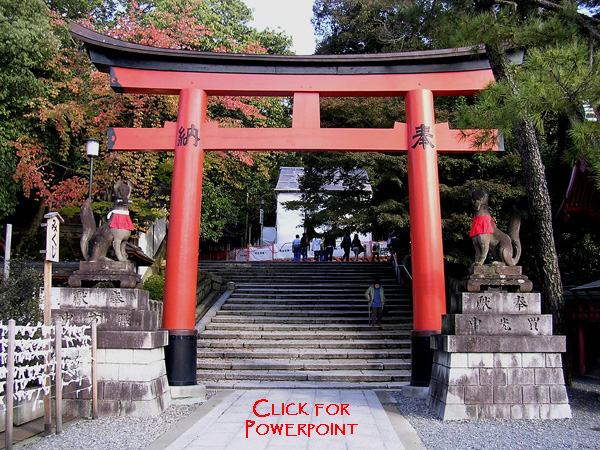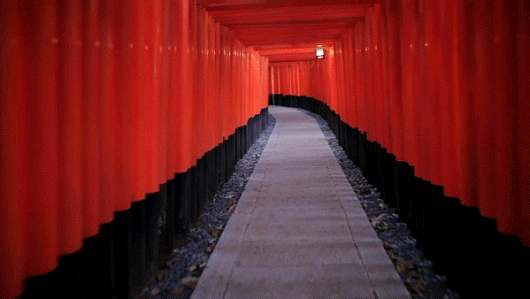
|
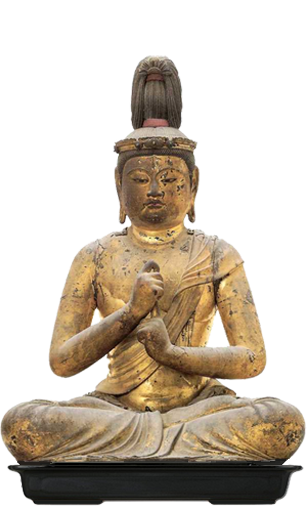
|
The
Buddhist theory of honji-suijaku
(“original substance manifests traces”) pervaded practically the whole of
Shinto. The theory of honji-suijaku,
transmitted from China to Japan, became
the theoretical foundation for considering Japanese kami as “manifest traces” (suijaku)
or counterparts of the “original substance” (honji) of particular Buddhas and bodhisattvas. For example, as early as the Nara period, Hachiman was considered both a kami and a bodhisattva without a clear distinction of Shinto or Buddhist
identity. In later periods almost every Shinto shrine considered its enshrined kami as the counterpart of some Buddha
or Buddhist divinity. It was customary to enshrine statues of these Buddhist
counterparts in Shinto shrines, and this practice further encouraged the
interaction of Buddhist and Shinto priests. (Japanese Religion, 120-1)
The honji suijaku theory was an extension of the idea that the universe
is really the activity of the Cosmic Buddha and that everything we think of as the cosmos is only the symbolic
expression of this activity. Hence all the various buddhas and bodhisattvas are
ultimately symbolic expressions, almost like emanations, of the single Cosmic
Buddha. For esoteric Buddhism, the “ground of reality” (honji) is Buddha-filled; but this ground has “traces” (suijaku) giving us the kami-filled world of Shinto belief. By
this reasoning, the various kami are
surface manifestations of buddhas existing on a deeper level of reality (which
are themselves emanating from the Cosmic Buddha).
The honji suijaku theory was, therefore, an explanation of how a
universal (Buddhist) reality could become localized as a Japanese (Shinto)
reality. This is fully in accord with the more traditional esoteric Buddhist
belief that the entire cosmos is the Cosmic Buddha and the world as we know it
is the manifestation of the activities of this Buddha. Esoteric Buddhists use
mandalas to portray how all buddhas emanate from the Cosmic Buddha (usually
considered Dainichi).
In accord with the honji
suijaku theory, so-called suijaku
art developed similar mandalas with kami
portrayed in place of the buddhas. This usually meant that Amaterasu replaced
Dainichi at the mandala’s center, suggesting in effect that all the kami emanated from her. In short:
esoteric Buddhist theory tended to fuse with traditional Shinto beliefs by
intellectually assimilating it, making it a manifestation — but only one
manifestation — within the broader Buddhist worldview. (Shinto: The Way Home, 98)
|

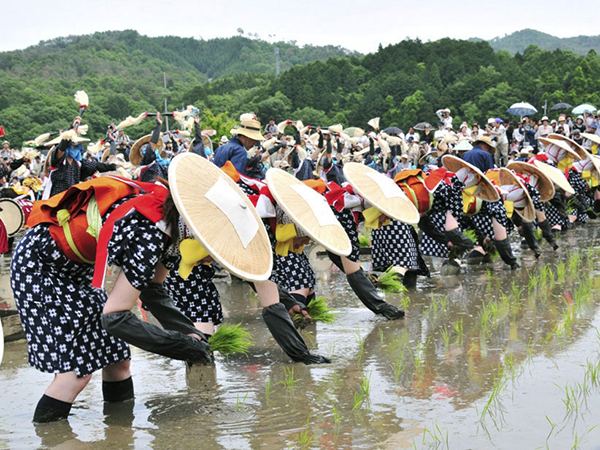
|
Born Shinto
Shinto for the Rituals of Life
In
the relationship between Shinto and Buddhism, the former typically
focuses on rituals associated with the living, while the latter is
closely associated with rituals for the dead.
Ofuda & Kamidana
Talismans for the Home Shrine

First Shrine Visit

|

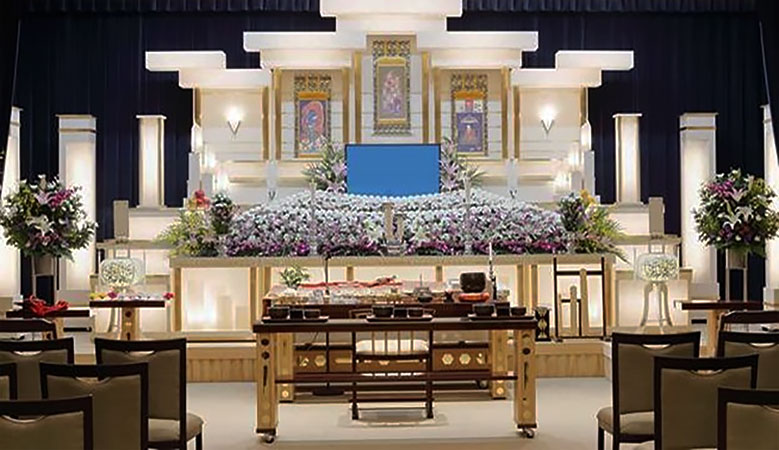 |
|
Die Buddhist
Buddhism for the Rituals of Death
[During the Edo period (1600-1868)] every family was legally required to belong to a Buddhist temple
and had to be questioned periodically by the temple priest. “At one stroke, all
Japanese were incorporated administratively into the existing Buddhist
structure.” Births were registered and deaths were recorded in the local temple
to which the family belonged. ... The general situation tended to stifle religious
devotion, especially at parish Buddhist temples where family membership was
obligatory; temple members’ “relationship with Buddhism often came to be more
formalistic and pragmatic rather than a matter of individual religious
conviction.” The Japanese historian Anesaki has described the general
situation: “For the people at large religion was rather a matter of family
heritage and formal observance than a question of personal faith.” ... To the present day, the organized sects of Japanese Buddhism have not been able
to escape completely the unfavorable stigma of disinterested affiliation. Both
enlightened priests and devout laypeople have often deplored the inertia of
Tokugawa “feudal” patterns of Buddhist ancestor worship and have lamented the
lack of a strong, personal Buddhist faith in the setting of parish temples. (Japanese Religion, 146-7)
The death of a person
sets in motion a series of rites and ceremonies that culminates in the
observance of a final memorial service, most commonly on the
thirty-third or fiftieth anniversary of death. Between a person’s last
breath and the final prayers said on his behalf, his spirit is ritually
and symbolically purified and elevated; it passes gradually from the
stage of immediate association with the corpse, which is thought to be
both dangerous and polluting, to the moment when it loses its
individual identity and enters the realm of the generalized ancestral
spirits, essentially purified and benign. ...
An outstanding feature of the ceremonies
for the dead is that from start to finish they are primarily the
responsibility of the household and its members, for all of whom,
regardless of sex and of age at death, these same devotions will be
performed in some degree. Indeed, the longer the time since a person’s
death, the more likely that only household members will look after his
spirit. Many people will attend the funeral; fewer will attend the
rites of the forty-ninth day; and the number will dwindle over the
years as the memorial services are marked. The priest, too, has less
and less to do with rites for the deceased as time passes. It can be
said without exaggeration that the household members alone, through
their observance of the rites, prevent the ancestors from becoming
wandering spirits. ...
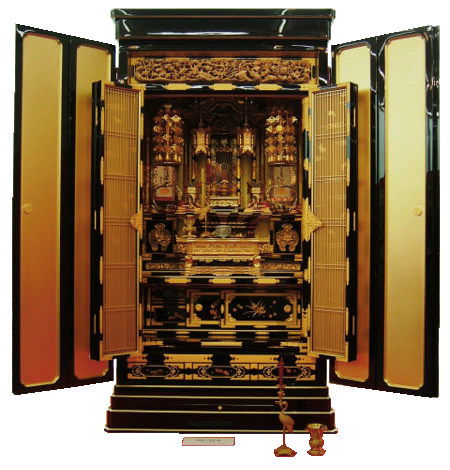
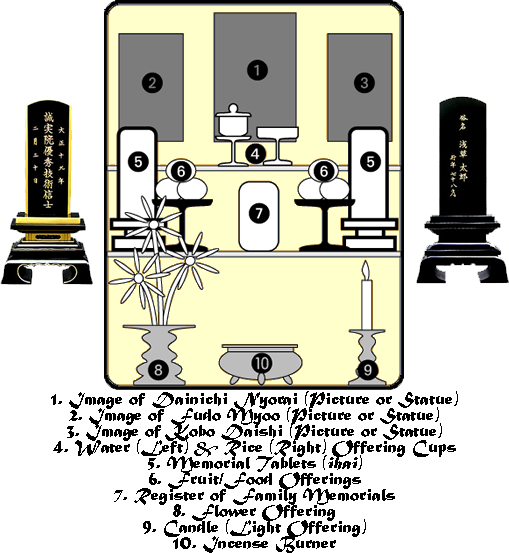
|
|
Haka Mairi and the Rites of O-Bon
Along with the butsudan the other great focus of unity and centre of ancestral rites is the haka,
the family grave, where usually ashes of all the family decesased are
interred. ... The grave is simultaneously a special place of contact
between the living and their ancestors, a receptacle for the spirits of
the ancestors, a site for ritual offerings to the dead and a symbol of
family continuity and belonging. ... The graves are usually in some
sanctified ground, such as within the precincts of the family temple
which thus oversees and protects the grave, with the priest conducting
occasional rites to this effect. But maintaining the grave properly is
the responsibility of the family and involves making offerings and
periodically cleaning it, and this is a vital aspect of the
relationship between the living and the dead, a means through which the
living may express their feelings for the dead and uphold the vital
balance and relationship through which the ancestors look after the
living. Failure to do this correctly may, just as with neglect of the butsudan,
invite problems: it is not infrequent for people who go to diviners or
to the new religions for help with personal problems such as illness to
be told that the cause of the problem lies in their failure to look
after the grave properly or that the grave has been badly sited and
requires changing. ...
The grave, then, continues to be a central element in all the rites surrounding death: in fact haka mairi remains
the single most widely performed religious activity in Japan, carried
out, as was mentioned in Chapter 1, by close to 90 per cent of all
Japanese people, young and old alike. It is primarily done at a number
of set times in the year, especially at higan (literally the ‘other shore’), the period around the spring and autumnal equinoxes, and the o-bon
festival in mid-July or August (the timing varies depending on the
region). Many families also visit their ancestors’ graves over the New
Year period as well. At these times it is customary to visit and clean
the graves, making offerings of food and drink to sustain the ancestors
in the other world and calling in a priest to read Buddhist prayers for
the benefit of the dead and to help them in their journey to full
enlightenment (the ‘other shore’ implied in the name higan). ...
The Bon Dance (bon odori) welcomes ancestors back to their graves and household altars ...
... and Buddhist priests are hired to perform memorial services on their behalf.
The most active and
demonstrative time for family unity and festivities connected with the
ancestors is the summer festive time of o-bon.
This is the period when the souls of the dead are considered to return
to earth to be with their living kin: since the ancestors are also felt
to reside in the ihai and to be encountered at the butsudan
throughout the year there are clearly some logical inconsistencies
here, but these appear of little relevance and are hardly ever
commented upon. (Religion in Contemporary Japan, 96-9) |
|

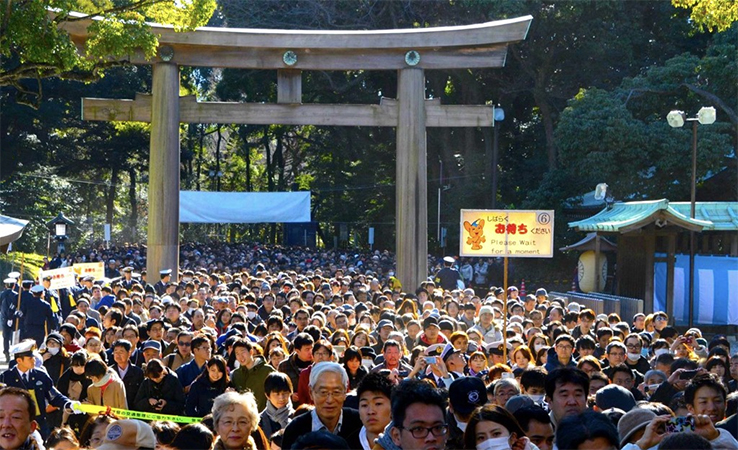
|

New Year’s Rituals
at Tsubaki Grand Shrine

|


